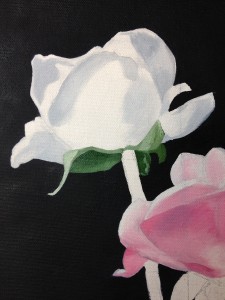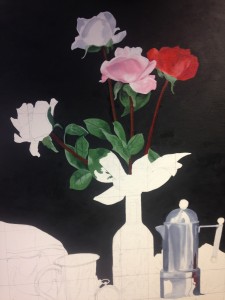|
|
 Today I hoped to get the stems and leaves moulded, on the first layer. After a bit of colour selection I came up with a mix that was largely opaque for the leaves, meaning that the top layer will almost entirely block out anything underneath. Chrome oxide and Titanium White are both opaque colours, and although I used a translucent green as well, it was never on its own. That means that although I did not finish all of the leaves, I will not have to paint over any of them, except for finishing touches and repairs, so in that at least, I am ahead of the game. The rather ghostly effect of the white rose needed relatively pale leaves, but even so they are close to overpowering it. Once I get a second layer of white and grey on, I can add more subtlety. I can do that once everything else is in place, and I know how it all needs to balance. Today I hoped to get the stems and leaves moulded, on the first layer. After a bit of colour selection I came up with a mix that was largely opaque for the leaves, meaning that the top layer will almost entirely block out anything underneath. Chrome oxide and Titanium White are both opaque colours, and although I used a translucent green as well, it was never on its own. That means that although I did not finish all of the leaves, I will not have to paint over any of them, except for finishing touches and repairs, so in that at least, I am ahead of the game. The rather ghostly effect of the white rose needed relatively pale leaves, but even so they are close to overpowering it. Once I get a second layer of white and grey on, I can add more subtlety. I can do that once everything else is in place, and I know how it all needs to balance.
After I had painted this opened bud to show how the green colours went, I painted down the stem, and brought the background in to the edge. The stem was always going to have to follow a gentle curve, and painting it only in the background would have made it rough. I left enough room for the woodier parts of the rose on day 2, and then crept the background towards fresh paint today. Cutting one colour into another works best when both colours are wet. The pink, red, and as yet unpainted yellow rose had reflections on the remains of the bud covers, but fortunately the colours I was using today had in many cases already been used, so it was easy to cover that without adding something new. There is a little of the background grey in the leaves, but mostly it is a white and two greens.
 Several times, I had to decide where leaves were to go, and what form they had. The outlines were already there, but within that there was room for them to flex. If they did not show liveness, they would just look like plates, and that would be boring to look at. So, in many cases I edged the leaves out over the background, and I made sure that the undersides were showing here and there. Although I had left the shapes, I had not always recorded which leaf went where, and I had elected to edit out a huge amount of foliage to make the picture clearer. Today I was left with the results of that decision, which was that I was doing less painting but a lot more thinking. Several times, I had to decide where leaves were to go, and what form they had. The outlines were already there, but within that there was room for them to flex. If they did not show liveness, they would just look like plates, and that would be boring to look at. So, in many cases I edged the leaves out over the background, and I made sure that the undersides were showing here and there. Although I had left the shapes, I had not always recorded which leaf went where, and I had elected to edit out a huge amount of foliage to make the picture clearer. Today I was left with the results of that decision, which was that I was doing less painting but a lot more thinking.
My brain rebelled at further thinking halfway through a large leaf. The light had already failed, so I was painting under the room lights, which I decided was fine as I had already chosen the colours, and knew what I was mixing. I went and had a tea break, and then did spot fixes, mostly to the background where there had been smudges, but also to the darker parts of the leaves. I left the big leaf at its turning point, where everything was a plain colour I would not have to mix to. Although I often spend a lot of time creating the right colours before I paint, in this case chrome oxide was perfect for the job. There is a drift of that pigment all the way across most of the leaves, where they turn from dark to light.
After that I called it a day, as it was 6pm and I needed to tidy up, which takes half an hour for a quick day. I only had four brushes to wash, so it was not much of a problem. Some days have ten or more, and that can take an extra half hour.
~~~
As a reminder, you can follow me on Twitter as @dianaprobst, where I often tweet pictures of my painting as I do it, and Facebook at DianaProbstCambridge for regular announcements of painting projects and other things I am working on.
|